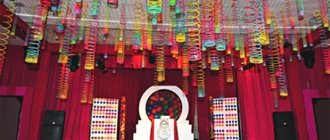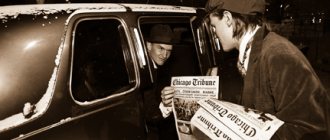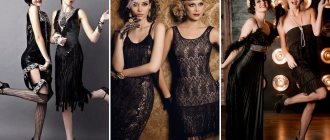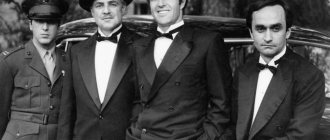During the era of the Great Depression and Prohibition in the United States, gangsters became the new heroes. Sharply dressed guys like Al Capone and John Dillinger regularly appeared on the pages of crime chronicles, becoming celebrities and trendsetters. They were imitated in life and on the silver screen. The best actors of the time, from James Cagney to Edward G. Robinson, portrayed tough, unscrupulous guys in three-piece suits, fedoras and the ever-present Thompson machine gun.
We tell you how it all began and how their image has evolved over almost a hundred years.
Canonical gangster
Al Capone may not have been the most powerful gangster in American history, but he was certainly the most famous. In addition to his countless crimes and misdeeds, Capone was also known for his good taste. It is no coincidence that his appearance is strongly associated with the concept of the canonical gangster style.
Al Capone with a bodyguard / Photo: Getty Images
Al Capone did not skimp on clothes and accessories. Like any self-respecting gangster, he made suits only to order and could spend $500 at a time (about $6,500 in today's dollars) to buy custom Italian silk fabric. Capone preferred three-piece striped suits. His collection included dark gray, navy and beige suits, but there was also room for bright colors - purple or lime. The look was completed with a classic white shirt, a silk tie and a handkerchief in the breast pocket of the jacket, white gloves, pearl-gray leg warmers (hello to Columbo from the comedy Some Like It Hot, who, by the way, was played by George Raft, who in his youth worked as a chauffeur for Capone) and a Borsalino fedora (a favorite Italian brand of gangsters) in white or cream. In the cold season, Capone usually wore a double-breasted coat, sometimes with a contrasting collar.
According to rumors, Capone's wardrobe consisted of more than one and a half hundred suits and the same number of pairs of shoes. He mostly wore expensive brown or black Oxfords, but in warm weather he could also wear brogues, popular among gangsters. Well, a rare portrait of a mafioso was complete without a cigar. Capone was very sensitive to how the public would see him. Therefore, he always asked photographers to shoot him from the right side, so that the scars on his left cheek would not be visible, because of which he received the nickname Scarface.
Oxfords and brogues are an English style of low-heeled lace-up boots. The difference between them is that oxfords are of aristocratic origin (it is believed that they were invented by Oxford students, hence the name), are made without unnecessary decorations and only with a closed type of lacing, while brogues have perforations on the toe and other parts (a distinctive feature is figured cut-off toe, reminiscent of the letter W), and their predecessors were peasant shoes. That's why in the movie "Kingsman: The Secret Service" the password for trained spies was the phrase: "Oxfords, not brogues." The former were worn only with suits, tuxedos or tails, the latter suggest a less formal style of clothing and look more festive - for example, they can be black and white. It is these brogues that have become a hallmark of the gangster style.
Al Capone / Photo: Getty Images Photo: Getty Images Photo: Getty Images
Mafioso's choice
- The image of a gangster has a lot in common with the style motifs of the Prince of Wales. But the gangsters chose smooth fabrics rather than wool or tweed as the material for their suits.
- The color scheme was not varied; it was mainly grey, brown, blue and their shades. Small vertical stripes were also in trend.
- The preferred models were the three-piece with a double-breasted jacket or the classic two-piece. Moreover, the suit had to fit perfectly.
- Shirts in bright colors were especially prized. They are ideally perfectly ironed. However, they wore not only plain ones, but also thin stripes, and also with white cuffs and collar.
- Accessories. A gangster's tie is always dark with a small amount of shiny fiber. And the butterfly was a symbol of special chic. Not a single mafioso, as a rule, Borsalino, could do without a hat. This is a model produced by the Italian company of the same name, made of soft felt, with 3 dents on the crown, wrapped with a ribbon once. A pocket watch on a chain, a silk scarf in a jacket pocket, cufflinks, a collar pin - all these are indispensable attributes of a gangster's suit. Like patent leather leggings, which, however, quickly went out of fashion.
- Shoes - brogues, that is, shoes made of leather with holes punched in it. Patent leather boots with rounded toes are also a sign of gangster style.
Gangster style of the 1930s: Capone in the movies
The cult figure of Capone is confirmed by the large number of biographical films about him, as well as fictional film characters, largely inspired by his personality. The most striking hero, for whom Capone became the prototype, is Tony Camonte played by Paul Muni from the famous Howard Hawks film “Scarface” (1932). Capone himself liked this picture so much that he even hung a poster in his home.
The most iconic thing in the picture is Camonte’s completely striped look (a hint at the gangsters’ sometimes changing taste and excessive pretentiousness of their appearance), a suit with a double-breasted jacket made of striped brown wool, a striped shirt and... a striped tie. As they say, it dazzles the eyes a little, but it’s memorable.
Paul Muni in Scarface (1932)
The most authentic portrayal of Capone on the big screen was Robert De Niro's role in Brian De Palma's The Untouchables (1987). The actor, with his usual thoroughness, approached the development of the image. De Niro did not have time to gain weight for the role of an obese mafioso (in the end he had to use pads hidden under his clothes), but he specifically sought out the real tailors who trimmed Capone. Therefore, contrary to popular belief, De Niro's costumes in this film were not made by Giorgio Armani (he made clothes for the lawmen led by Kevin Costner), but by tailor Henry Stewart. De Niro even insisted that the shirts be made from the same silk that the gangster wore, in order to further get into character.
Richard Bruno, De Niro's personal costume consultant, managed to obtain two blanks of Borsalino hats with Capone's initials, which he eventually used to make the actor's hats. The camel-colored coat with a contrasting brown velvet collar that the on-screen Capone wore as he walked down the stairs of the Lexington Hotel was very similar to the one the gangster was photographed wearing in newspaper photographs. Finally, an important element of the image is glasses with tinted lenses in tortoiseshell frames, which had not previously appeared on the screen of Capone. The style of glasses is more in keeping with the 1980s than the 1930s, when thinner frames were in fashion. However, they are not accidental and clearly refer to images of Capone in 1941, when he was released from Alcatraz prison.
Robert De Niro in the film “The Untouchables” Al Capone / Photo: Getty Images Al Capone and Robert De Niro
Gangsters in the 1930s chose double-breasted Kent jackets, named after Duke George of Kent, the younger brother of the Prince of Wales. Four or six buttons, wide lapels reaching to a high waist and straight tails without slits - all this created the illusion of slimness and height for short gangsters.
A cinematic mockery of the gangster fashion of the 1930s was Warren Beatty's Dick Tracy (1990), where the head of the Chicago mafia group, Big Boy Caprice, from the film version of Chester Gould's popular comic books, is a parody version of Al Capone. In this role, Al Pacino had a blast. Milena Canonero's costumes (Oscar nomination) and stunning makeup (Oscar Award) work perfectly to create a grotesque image: greasy, slicked-back hair, a huge nose, a hump, disproportionately huge shoulders and butt for a short person. This entire ridiculous caricatured figure is dressed in flashy ensembles of red and sea green striped suits, matching coats with astrakhan collars and colored homburgs (a hat with a longitudinal crease at the top and curved brim). The finishing touches of the exaggerated gangster style are green suspenders and fancy ties.
Al Pacino in the film Dick Tracy Al Pacino in the film Dick Tracy
Party for gangsters
For people looking to capture the essence of the 1920s at their upcoming costume party, here are a few tips to help you put together a striking outfit. Choose a quality tuxedo that fits your figure (suitable for women and men), polish your shoes to a shine, add accent (preferably expensive) accessories and grab cigars and a toy gun, fully completing the look of a gangster with a hat. Ladies who want to emphasize their femininity look natural in fashionable dresses of the 20s.
Gangster Party
Gangster style 1940-1950s: Don Corleone
Marlon Brando, who took powerful revenge for the acting failures of the 1960s in Francis Ford Coppola's The Godfather, created one of the most iconic film images. The most recognizable and subsequently quoted costume of the patriarch of the mafia clan Vito Corleone, which he wears to his daughter’s wedding in 1945, is a black tuxedo, white shirt, black vest, black bow tie and red rose in his buttonhole. A purring cat (Brando’s own find) on his knees adds deceptive goodwill and sentimentality to the image.
Marlon Brando as Don Vito Corleone
As for Michael Corleone (Al Pacino), the first Godfather's costume designer Anna Hill Johnstone (Oscar-nominated) masterfully conveyed the evolution of his image from an enthusiastic romantic in military uniform to a cold-blooded don in the finale. If at first Michael prefers clothes in warm brown shades, including a corduroy jacket and coat, then, after returning from Sicily, where he temporarily adopted the relaxed style of the locals (cap, stand-up collar shirt, striped vest), Pacino’s hero begins to dress like a typical mafioso: discreet and elegant three-piece suits, Homburg hat, suspenders. An additional striking touch, added to his image in the second part by Oscar-nominated artist Theadora van Runkle, is the elegant neckerchiefs that Michael wears instead of ties in the 1950s in Cuba and at home in informal settings.
Al Pacino as Michael Corleone Al Pacino as Michael Corleone Al Pacino as Michael Corleone Al Pacino as Michael Corleone
Gangster style 1960-1980s: Nice Scarface
Martin Scorsese's gangster saga Goodfellas (1990), considered by many to be perhaps the best film of the director's career, covers several decades (from 1955 to 1980) in the life of Henry Hill (Ray Liotta). Costume designer Richard Bruno traces the evolution of the main character through changes in his wardrobe - from the typical double-breasted beige suit that he buys for himself with one of his first criminal fees, through the smart suits and leather and velvet jackets that became fashionable in the 1970s, to the blue terry the robe of an ordinary US citizen (or, as the voice-over says, an ordinary nonentity) from the finale of the film. Some of the fine suits for members of the New York mafia were provided by designer Giorgio Armani. Scorsese paid special attention to the jagged white collars of the characters' shirts, and entrusted the ironing process exclusively to his mother Catherine (she played the role of Tommy's mother in the film). According to the director, the tight collar was supposed to symbolize the iron grip of the mafia, which firmly holds the “good guys” by the throat.
Joe Pesci and Ray Liotta in the movie "Goodfellas" Ray Liotta, Robert De Niro, Paul Sorvino and Joe Pesci
In Scarface (1983), a remake of the seminal 1930s film, Brian De Palma turned the title character into Cuban immigrant Tony Montana (Al Pacino again), who has made a meteoric career in drug trafficking in Miami. Before his takeoff, the hero wears mostly Hawaiian shirts, but then switches to foppish three-piece suits, which he combines with contrasting shirts with an apache collar and the always matching scarf in the breast pocket. A sort of gangster chic with a touch of disco. Thus, in the scene when Tony visits his family in a white suit and dark shirt, he painfully resembles another Tony played by John Travolta from the cult film “Saturday Night Fever” (1977). And the black pinstripe suit from the bloody finale clearly references Paul Muni's iconic striped suit from the classic 1932 film.
Al Pacino in the film Scarface Al Pacino in the film Scarface Al Pacino in the film Scarface John Travolta in the film Saturday Night Fever (1977)
1970s Gangster Style: The Most Stylish Mafioso
Las Vegas casino manager and mafia henchman Sam Rothstein from Martin Scorsese's Casino (1995) has become one of the most stylish characters in Robert De Niro's pantheon of gangsters. His real prototype, Frank Rosenthal, nicknamed Lefty, was known as a fashionista and a dude. Costume designer Rita Rajek and Robert De Niro even made a special trip to Florida to talk with Frank and get acquainted with his photo archive for the most authentic recreation of his eccentric style on screen. Rothstein has 70 sets of clothes in the film (with a total budget of $52 million, more than $1 million was spent on costumes). Moreover, despite the deliberate kitschness of the images (the main time period is the fashion-crazy 1970s), De Niro manages to wear ensembles from the most daring color combinations and at the same time look not tasteless, but incredibly stylish.
Robert De Niro in the film "Casino" Robert De Niro in the film "Casino" Robert De Niro in the film "Casino" Robert De Niro in the film "Casino" Robert De Niro in the film "Casino"
Rothstein's clothes reveal the evolution of the hero's image. The more he gets involved with the mafia, the more extravagant his style becomes. All of Rothstein's looks were painstakingly created, from specially dyed socks to the use of authentic 1970s silk fabrics. It was thanks to De Niro's dapper wardrobe in Casino that the combination of a shirt and tie of the same color came into fashion.
Map of De Niro's costumes in Casino
Images for a photo shoot
Capturing the moment in the style of the roaring 1920s is quite simple. All the future model needs is to use theoretical recommendations, be in a good mood and, of course, watch gangster films about influential mafiosi for inspiration! Well, authentic mafia photos that perfectly convey the style of gangsters for your photos can be found on popular fashion platforms.
Gangster fashion 2021: And now “The Irishman”
When the award-winning costume designer Sandy Powell (she has six collaborations with Scorsese under her belt, and three Oscars, including an award for “The Aviator”) was offered to participate in the filming of the epoch-making “The Irishman” (the film tells the real story of Frank Sheeran, who for many years “painting houses”, that is, killing people on the orders of the Philadelphia mafia), then, soberly assessing the scale of the upcoming work (to dress 421 heroes and about 6,500 extras over five decades and, accordingly, five different fashion periods), she asked for help to Christopher Peterson. He had already collaborated with Powell on such films as “The Departed,” “The Wolf of Wall Street” and “Carol,” and she was extremely pleased with their creative tandem.
Christopher Peterson and Sandy Powell / Photo: Getty Images
In their numerous interviews, the artists talk about this being a movie about gangsters who don’t look like the usual heroes of the genre. They don't dress to stand out or be noticed. They shouldn't attract the attention of the public or photographers while doing their thing. Therefore, Scorsese immediately gave a clear instruction: no elaborate models and peacock flowers. Heroes should not be dressed loudly or provocatively. This is especially true for Robert De Niro's character, because Frank is a killer, and he should not attract too much attention to himself. Each decade has its own palette: the 1950s are gray-blue shades, the 1960s are mustard and olive tones, the 1970s are burgundy and brown colors.
Most of the characters in the film are real people, so Powell and Peterson had to conduct especially careful research of photographic and video materials. As luck would have it, Sheeran's granddaughter, Brittany Griffith, worked in the costume shop and willingly provided the family archive with many photographs of Frank at various ages, as well as his Liberty ring and engraved gold watch so that artists could recreate them.
De Niro had 102 costume changes on screen. During the pre-production stage, the actor had to attend about 15 fittings, each lasting four hours. Some items were purchased or rented, but a third of the wardrobe was made from scratch. Naturally, over the decades, the hero’s style has changed - from simple, cheap clothes (a checkered shirt, a leather jacket - by the way, genuine vintage 1950s - and a cap, which, in fact, corresponded to his work as a truck driver) to more expensive and high-quality things and in particular good suits. So, if in the scene of the christening of his newborn daughter (early 1950s) Frank is wearing a somewhat outdated ready-made suit with a jacket with wide lapels, then by the end of the 1950s, when he was already earning good money, current models with narrower lapels appeared in his wardrobe . And his checkered jacket, turquoise polo and beige chinos are definitely 1970s.
Robert De Niro in the film "The Irishman" Robert De Niro on the set of Robert De Niro in the film "The Irishman" Robert De Niro in the film "The Irishman"
Sheeran's favorite image for artists is his appearance in a nursing home: a white shirt, vest and high-waisted sweatpants; they are a little too big and that’s why the hero looks so pitiful and small.
Fun fact: since the real Frank Sheeran was 15 cm taller than his friend Jimmy Hoffa, to maintain authenticity, De Niro was forced to wear high platform boots in his scenes with Pacino, because the difference in height between the actors is actually not that great.
Al Pacino and Robert De Niro on the set of "The Irishman"
Ties and red cap
Since Russell Bufalino (Joe Pesci) is older than the rest of the characters and has long held a high place in the mafia hierarchy (he is the boss of a small but influential family in northeastern Pennsylvania), he is better dressed than many. The main feature of his style are ties with fancy prints. At the same time, Bufalino dresses quite conservatively: in the 1960s, he wore suits in the fashion of the 1950s. But the freedom-loving 1970s do not leave Ras on the sidelines. On the way to his daughter's wedding, he is wearing a polo and slightly flared light trousers.
Joe Pesci in the movie The Irishman
Jimmy Hoffa (Al Pacino) - the leader of the American Teamsters union, incredibly popular in the 1950s and 1960s - is captured in many photographs and newsreels. Hoffa, although he had connections with the mafia, always stood up for the interests of the working class and even dressed quite modestly as a sign of solidarity. His suits were ready-made, store-bought, not custom-made. Also, the real Hoffa had a weakness for white socks, he could wear them with anything: a dark blue suit, black shoes and white socks - please. His red fur hunter's hat, similar to the one worn by the cartoon hunter Elmer Fudd, is also memorable.
Al Pacino in the film The Irishman Al Pacino in the film The Irishman Al Pacino in the film The Irishman Jimmy Hoffa in a winter hat Elmer Fudd
As we can see, gangsters in movies are a headache, a challenge, and an incredible pleasure for a costume designer. The viewer may think that dressing up as a mafioso is a piece of cake; in fact, Robert De Niro has changed more costumes in his gangster film life than Sarah Jessica Parker in Sex and the City, and has become a trendsetter in men's fashion no less than Carrie Bradshaw. And in the dressing rooms of Tony Montana and Sam Rothstein there are so many clothes and shoes that Carrie never dreamed of. The gangster style on screen has undergone changes, maintaining the continuity of traditions and reflecting the fashionable signs of the times (the classic three-piece suit and long leather coat of Al Pacino’s character from “Carlito’s Way”). One thing remains unchanged: even 100 years later, “manners are a man’s face,” and a fedora, suit and brogues are his sure-fire decoration.
Modern gangsters
Over time, this style has not lost its popularity and main features; it is still pathos, pretentiousness and high cost. In general, the gangsters of the past are not much different from those of today; some of the excesses of luxury in women’s outfits have disappeared, for example, the abundance of feathers and furs, sparkles and rhinestones.
The image of men has hardly changed - except that they stopped carrying weapons (unless for a themed photo shoot), and bright shirts were replaced by white and black ones.
Classic suits have become typical for women - trouser suits, with a pencil skirt or vest, which gives a special elegance to the image and makes it somewhat similar to men's. The look can be completed with a tie or hat.
In conclusion, I would like to say that the gangster style is quite beautiful and fashionable, especially in our time, when images have become more classic and strict. In addition, the image of a bandit is very easy to create - for starters, a stylish suit will be enough, which can be complemented with any of the accessories described above.




